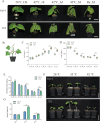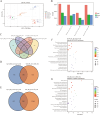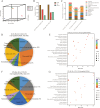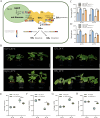Integration of transcriptome and metabolome reveals key regulatory defense pathways associated with high temperature stress in cucumber (Cucumis sativus L.)
- PMID: 39748295
- PMCID: PMC11694469
- DOI: 10.1186/s12870-024-05876-x
Integration of transcriptome and metabolome reveals key regulatory defense pathways associated with high temperature stress in cucumber (Cucumis sativus L.)
Abstract
High temperature stress seriously affects the quality and yield of vegetable crops, especially cucumber (Cucumis sativus L.). However, the metabolic dynamics and gene regulatory network of cucumber in response to high temperature stress remain poorly studied. In this study, we identified a heat-tolerant cucumber Gy14 and a heat-sensitive cucumber 32X. RNA-seq analysis of Gy14 and 32X under high temperature stress showed that some differentially expressed genes (DEGs) were related to the biosynthesis of secondary metabolites. Metabolomic analysis revealed that there were more phenylpropanoids and their downstream derivatives in Gy14 compared to that in 32X under Re_2d condition (2 normal days recovery after heat). Integrated analysis of transcriptome and metabolome revealed that these upregulated genes played a pivotal role in flavonoid biosynthesis. Moreover, high temperature stress significantly induced the expression of the gibberellin (GA) biosynthesis genes and exogenous application of GA3 alleviated the damage of high temperature to cucumber seedlings. Together, these findings provided new insights into the transcriptome response and metabolomic reprogramming of cucumber against high temperature stress.
Keywords: Cucumber; Flavonoids; High temperature stress; Metabolome; Transcriptome.
© 2024. The Author(s).
Conflict of interest statement
Declarations. Ethics approval and consent to participate: The cucumber seeds used in this study are stored in our laboratory and are commonly used experimental materials. The methods involved in this study were carried out in compliance with local and national regulations. Consent for publication: Not applicable. Competing interests: The authors declare no competing interests.
Figures







Similar articles
-
Unveiling Molecular Mechanisms of Nitric Oxide-Induced Low-Temperature Tolerance in Cucumber by Transcriptome Profiling.Int J Mol Sci. 2022 May 17;23(10):5615. doi: 10.3390/ijms23105615. Int J Mol Sci. 2022. PMID: 35628425 Free PMC article.
-
Heat Stress Resistance Mechanisms of Two Cucumber Varieties from Different Regions.Int J Mol Sci. 2022 Feb 5;23(3):1817. doi: 10.3390/ijms23031817. Int J Mol Sci. 2022. PMID: 35163740 Free PMC article.
-
Integrated Metabolome and Transcriptome Analysis Provides New Insights into the Glossy Graft Cucumber Fruit (Cucumis sativus L.).Int J Mol Sci. 2023 Jul 29;24(15):12147. doi: 10.3390/ijms241512147. Int J Mol Sci. 2023. PMID: 37569524 Free PMC article.
-
Transcriptional and metabolite analysis reveal a shift in direct and indirect defences in response to spider-mite infestation in cucumber (Cucumis sativus).Plant Mol Biol. 2020 Jul;103(4-5):489-505. doi: 10.1007/s11103-020-01005-y. Epub 2020 Apr 18. Plant Mol Biol. 2020. PMID: 32306368 Free PMC article.
-
Revisit and explore the ethylene-independent mechanism of sex expression in cucumber (Cucumis sativus).Plant Reprod. 2024 Dec;37(4):409-420. doi: 10.1007/s00497-024-00501-1. Epub 2024 Apr 10. Plant Reprod. 2024. PMID: 38598160 Review.
Cited by
-
Integrated transcriptomic, metabolomic and lipidomic analyses uncover the crucial roles of lipid metabolism pathways in oat (Avena sativa) responses to heat stress.BMC Genomics. 2025 Aug 28;26(1):780. doi: 10.1186/s12864-025-11972-5. BMC Genomics. 2025. PMID: 40877772 Free PMC article.
-
Phenylpropanoids metabolism: recent insight into stress tolerance and plant development cues.Front Plant Sci. 2025 Jun 26;16:1571825. doi: 10.3389/fpls.2025.1571825. eCollection 2025. Front Plant Sci. 2025. PMID: 40641862 Free PMC article. Review.
References
-
- David BL, Wolfram S, Justin C-R. Climate trends and global crop production since 1980. Science. 2011;333:616–20. - PubMed
-
- David SB, Rosamond LN. Historical warnings of future food insecurity with unprecedented seasonal heat. Science. 2009;323:240–4. - PubMed
-
- Cohen SP, Leach JE. High temperature-induced plant disease susceptibility: more than the sum of its parts. Curr Opin Plant Biol. 2020;56:235–41. - PubMed
-
- Hua J. Modulation of plant immunity by light, circadian rhythm, and temperature. Curr Opin Plant Biol. 2013;16(4):406–13. - PubMed
MeSH terms
Substances
LinkOut - more resources
Full Text Sources

